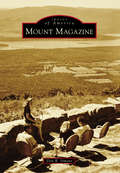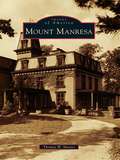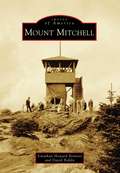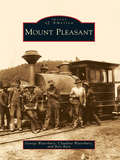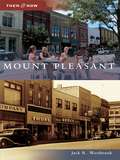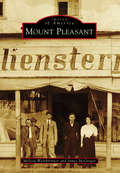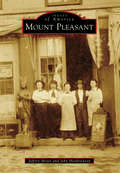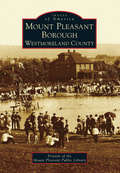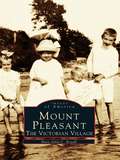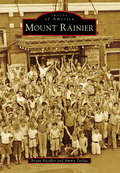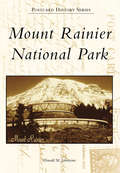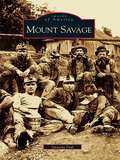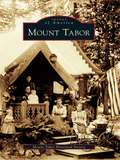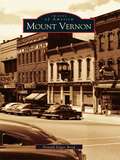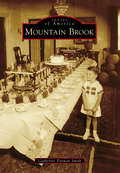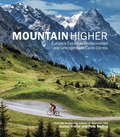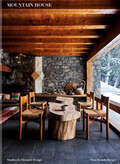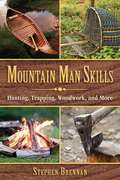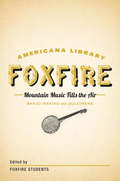- Table View
- List View
Mount Magazine (Images of America)
by Don R. SimonsThe first known written description of Mount Magazine came from Thomas Nuttall, a noted English botanist, in 1819. Since then, the highest mountain in Arkansas has come to mean many things to many people. To the first settlers of European descent, it was a place to scratch out a living and raise a family through hard work and hardships. To those enduring the Great Depression, it meant jobs. The end of World War II brought numerous outdoor activities. Adventurous recreationists found many ways for the mountain to challenge their abilities. Scientists studying its biological communities discovered unique fauna and flora. Finally, the past two decades have combined all those attributes in the development of Mount Magazine State Park.
Mount Manresa
by Thomas W. MatteoIn 1911, Rev. Terence Shealy purchased the Meyer estate on Staten Island. With magnificent views of the New York Harbor, the estate was a dream come true for Father Shealy. He was at the forefront of the lay retreat movement in the United States, and the Meyer estate was the perfect refuge for men to escape from the stress of everyday life. Judges and bricklayers came together to meditate and enjoy the beauty of this hilltop in rural Staten Island. The lay retreat movement grew and spread across the United States, with thousands coming to Mount Manresa. The house also had a strong relationship with Fordham University. The first retreat took place at Rose Hill campus, and three former Fordham presidents became directors of Mount Manresa after they left their posts in academia. Today Mount Manresa plays host to a multitude of retreats throughout the year, bringing more than 15,000 guests to the campus annually.
Mount Mitchell
by David Biddix Jonathan Howard BennettThe highest peak in the eastern United States, Mount Mitchell towers 6,684 feet over its home in Yancey County, North Carolina. It has borne silent witness to great scientific and personal achievements, tragic loss of life, heated debates, and a host of controversies both great and small. Once considered forbidding and remote, it claimed the life of its namesake, Elisha Mitchell, when he fell to his death in an attempt to firmly establish the mountain's height. In the early 1900s, entrepreneurs constructed a railroad, opening its old-growth forests to massive deforestation. This devastation stirred some of the earliest notions of environmentalism that led to Mount Mitchell's establishment as North Carolina's first state park. Today, it is a playground for tourists from around the world, offering some of the best hiking and views in the nation. Mount Mitchell showcases the rich history of the mountain along with the events and colorful characters that have shaped its story.
Mount Pleasant
by Bert Ruiz Claudine Waterbury George WaterburyMount Pleasant has deep American roots going back to the Revolutionary War, when local tenant farmers filled the ranks of General Washington's Continental army. For years, travel to New York City was difficult, until the arrival of the railroad in 1846 allowed easy transportation to lower Manhattan. In 1893, John D. Rockefeller Sr. began buying land in Pocantico and built his classic Georgian mansion. The massive Kensico Dam in Valhalla was completed in 1917 to satisfy the growing thirst of New York City. In 1927, Rose Hawthorne, the daughter of writer Nathaniel Hawthorne, completed the Rosary Hill Home to care for the unfortunate. The following year, Dewitt Wallace and his wife Lila moved to Pleasantville to launch the production of Reader's Digest. Through photographs, Mount Pleasant remembers these historic moments.
Mount Pleasant
by Jack R. WestbrookSince 1860, Mount Pleasant has been a center for Native American culture, lumbering, agriculture, oil and gas production, collegiate learning, and retail shopping; Mount Pleasant now boasts one of the largest gaming casino resorts in Midwest America.
Mount Pleasant
by James Mcgregor Melissa WeinbrennerMount Pleasant lies atop a tree-covered hill in the midst of East Texas timber country. The native Caddo Indians referred to the hill as "pleasant," and so it was named. Though it hails from within the historic area known as "Devil's Triangle," the city has been dubbed "the sweetest town in Texas." This area has been alternately ignored, fought over, and claimed, proving the people of Mount Pleasant are resilient, adaptable, and consistently hardworking. It is the kind of stable community that showcases many of the strengths of America. The city's location as a byway along transportation routes, including roads, railroads, and an interstate highway, has contributed to its growth over the years as industrial businesses have come to town. Named one of the best small towns in America, it currently serves as the trailer manufacturing capital of the United States. This "bass capital of Texas" boasts more than 17,000 acres for fishing, swimming, and waterskiing, as well as bird watching along the Texas Bluebird Trail.
Mount Pleasant (Images of America)
by Jeffrey Meyer John HendricksonFrom its earliest years, Mount Pleasant was known as the �Athens of Iowa�: a small town with a big story and a center of learning and culture. Even during the town�s pioneer era, the citizens of Mount Pleasant championed education, establishing numerous schools and a college. Progressive ideals, including abolitionism and women�s education, took root. As the home of Sen. James Harlan, an important ally of Abraham Lincoln, the city emerged as a bastion of support for the president. During the hardship of the Civil War, the community took up a second cause, becoming the location of the state mental health asylum. The drive for the improvement of life only increased, bolstered by the city�s numerous schools, churches, and most importantly a spirit of community.
Mount Pleasant Borough, Westmoreland County
by Friends of the Mount Pleasant Public LibraryMount Pleasant is a small borough in the Laurel Highlands of Westmoreland County with an immeasurable history. Originally a Native American trail, Main Street was used by Gen. Edward Braddock in 1755 on his journey to his 16th encampment. Generations have lived here since the town was incorporated in 1828. Many immigrants from Poland, Italy, Germany, and Ireland came here to work in the coal, coke, and glass industries, which were growing quickly and spurring successful businesses. The coke works of Henry Clay Frick was established in 1881. Bryce Brothers Glass began in 1896 and became well known for blown stemware and tableware. L.E. Smith Glass Company manufactured handmade American pressed glass in various colors and styles beginning in 1907. The success of these industries led to the Glass Festival, held annually in September. Today, in the center of town is Diamond Memorial Square, the quintessential symbol of Mount Pleasant, where the World War I doughboy was erected in 1924. Mount Pleasant Borough, Westmoreland County shares photographs and stories that illustrate the strong community ties of the area.
Mount Pleasant: The Friendly Town (Images of America)
by Mary-Julia C. RoyallLocated along the shores of the Charleston harbor, Mount Pleasant is a graceful, enchanting community known for its exquisite views of the water and landscape. Once comprised of five small hamlets, the area has seen phenomenal increases in both business and population, a growth that was correctly predicted when the John P. Grace Memorial Bridge linked the town with Charleston in 1929. It is a place where small-town charm lingers, even among the fast-paced life in which most residents now take part. Mount Pleasant: The Friendly Town begins the community's story where Mount Pleasant: The Victorian Village left off, and it bridges the 1930s with modern times. This compelling history illustrates the ways in which Mount Pleasant coped with the happenings of the 20th century, including such far-reaching events as World War II and the recovery following the Great Depression, and those much more intimate such as the devastation of Hurricane Hugo and the sesquicentennial celebration of the town. Readers will experience this unique area of South Carolina through the eyes of the residents who lived here during the town's coming of age.
Mount Pleasant: The Victorian Village (Images of America)
by Mary-Julia C. RoyallMount Pleasant: The Victorian Village is an intimate look at like in the area of the town now known as the historic district, during the slower-paced time before World War II. Called "The Village" by its citizens, this close-knit community along the edge of Charleston harbor was formed when five small English settlements merged in the nineteenth century to create the town of Mount Pleasant. The small town had its own identity and remained a "Victorian Village" due to its isolation from the outside world except by ferry. Rapid growth and change began with the opening in 1929 of the Grace Memorial Bridge over the Cooper River. The bridge linked cities to the north and south via Highway 40 (now 17), thus opening the door for tourism and commerce while creating local accessibility to Charleston.
Mount Rainier (Images of America)
by Jimmy Tarlau Bryan KnedlerMount Rainier began its history as an incorporated town in 1910 with the merging of several subdivisions that straddled Bunker Hill Road, a major route between the ports of Georgetown and Bladensburg. Before the Civil War, Thomas and Anna Clemson owned a 100-acre farm fronting that important road. Their family letters provide some of the earliest writings about the area. In 1891, Elizabeth and Estcourt Sawyer purchased the Clemson farm and named their subdivision Mount Rainier. In 1899, the real estate became especially attractive to commuters when the District of Columbia's streetcar system was extended through the heart of the present-day city; the route, now known as Rhode Island Avenue, later became part of US Route 1.
Mount Rainier National Park (Postcard History)
by Donald M. JohnstoneMount Rainier rises 14,410 feet above sea level and can be seen on any given day by over three million people and from over 100 miles away. It is America's fifth national park, established in 1899. The mountain is an active but currently dormant volcano. With 25 named glaciers, 50 smaller unnamed glaciers, and numerous perennial snowfields, Mount Rainier boasts the largest glacier system in the continental United States. In addition to the glacier zone, the park has alpine and subalpine forest and subtropical rain forest. Each zone has its own unique ecology of plants and animals. The vistas of and from the mountain are some of the most spectacular in all of the park system.
Mount Savage
by Amanda PaulThe town of Mount Savage, Maryland, is a small blue-collar town nestled at the base of Big Savage Mountain in the Allegheny Mountains, between Frostburg and Cumberland. The town began as a small farming settlement in the mid-1800s, but it was not until 1844 that the region was put on the nation's map with the pressing of the first iron rail in the United States. After this claim to fame, Mount Savage became the fifth largest city in Maryland. Named as the headquarters for the short line railroad and the Cumberland & Pennsylvania Railroad, the area was deemed an industrial center. In addition to the rail businesses, Mount Savage attracted a foundry, two brick refractories, and several local merchants. In this company town, the industries shaped the economy and topography of Mount Savage, building housing for workers and donating land for schools, churches, and other public buildings. The town was a cultural melting pot attracting English businessmen and Irish, Scottish, Welsh, Italian, and German workers. With this diverse mix of cultures, the identity of Mount Savage was molded into a close knit community. Despite the loss of the industries to the region, Mount Savage continues to celebrate its hard-working traditions. The photographs contained in Images of America: Mount Savage offer a fascinating look into the irreplaceable memories of the people and places that have made Mount Savage what it was, is, and will become.
Mount Sinai (Images of America)
by Ann M. BeckerTucked alongside a harbor on Long Island's north shore, Mount Sinai has long attracted residents and visitors. It was the site of an early European settlement in 1664 and the embarkation point of the Revolutionary War foray into enemy territory by Maj. Benjamin Tallmadge, a member of Gen. George Washington's Setauket spy ring. Mount Sinai was a farming and seafaring community in the 1600s, 1700s, and 1800s. In 1891, it became the site of the "sanitary resort" known as the Crystal Brook Park Association. Later, it drew an early community of artists and photographers who captured the natural beauty of the area. Mount Sinai portrays these and many other events of historical and cultural interest.
Mount Tabor
by Mount Tabor Historical SocietyOne of New Jersey's earliest permanent Methodist camp meeting grounds, Mount Tabor embodied the austere evangelical fervor of 1869. Canvas tents on 16-by-25-foot leased lots surrounded Trinity Park, the focal point of all religious and social activity for 10 days in late August. The camp meetings were hugely successful, and the growing community needed more permanent housing. Narrow, two-story Victorian cottages with intricate porches and balconies began to sprout on the lots. In 1885, the octagonal-shaped tabernacle, with its soaring walls and heaven-high ceiling, was built. As early as 1891, the religious summer colony expanded its recreational activities,and by 1912, Mount Tabor was more of a summer resort than religious retreat. After World War II, most of the 350 cottages were converted to year-round use, and Mount Tabor became a community within Parsippany, welcoming people from all religions and backgrounds. Today the unpretentious charm of its humble beginnings permeates the quaint community, and modern residents, like their forebears, are drawn to the rich, spiritual heritage of goodwill and the delightful cottages that invite fellowship.
Mount Vernon
by Donald Edgar BoydIn 1805, veterans of the American Revolution claimed a plot of land in Ohio as reward for their military service, settling the town of Mount Vernon. In honor of President George Washington, the town was named after his colonial farm, and Mount Vernon remained true to its image, earning it the nickname of "Ohio's Colonial City." The town takes pride in its many original, well-preserved grand historic homes and mansions. An architectural gem and America's oldest, authentic 19th-century theater, the Woodward Theater is currently being renovated and 200 years later, today's vehicles still rumble over the Colonial City's original brick streets.
Mount Vernon Revisited (Images of America)
by Donna M. Jackson Mayor Ernest Davis Dr Larry SpruillAn important gateway suburban community, Mount Vernon was formed around the construction of two commuter rail lines to and from New York City. In the first quarter of the 20th century, its contiguous borders with Greater New York, rapid population growth, automobiles, petroleum, and industrial development set the stage for the encroachment of urban realities on the upwardly mobile founders' hopes for a sustained and prosperous suburban lifestyle. Through images that illustrate the power of 20th-century transportation technologies, new energy sources, and dynamic demographic forces on this "City of Happy Homes," Mount Vernon Revisited commemorates pivotal milestones of the past 150 years while offering indicators of the city's potential and identity.
Mount Washington: Narratives and Perspectives
by Mike DickermanFor two centuries, Mount Washington has been the object of countless writers� wonder and fascination. In this volume, more than twenty previously written pieces inspired by New England�s highest peak have been carefully selected, and collectively these cover nearly every aspect of the mountain�s storied past. Tag along on early explorations of the White Mountains and its fabled Presidential Range. Follow the history of the nation�s first mountain-climbing train and witness many of Mount Washington�s tales of human tragedies. Editor and area historian Mike Dickerman explores the captivating history of one of the Granite State�s most remarkable places.
Mount Wutai: Visions of a Sacred Buddhist Mountain
by Wen-shing ChouThe northern Chinese mountain range of Mount Wutai has been a preeminent site of international pilgrimage for over a millennium. Home to more than one hundred temples, the entire range is considered a Buddhist paradise on earth, and has received visitors ranging from emperors to monastic and lay devotees. Mount Wutai explores how Qing Buddhist rulers and clerics from Inner Asia, including Manchus, Tibetans, and Mongols, reimagined the mountain as their own during the eighteenth and nineteenth centuries.Wen-Shing Chou examines a wealth of original source materials in multiple languages and media--many never before published or translated—such as temple replicas, pilgrimage guides, hagiographic representations, and panoramic maps. She shows how literary, artistic, and architectural depictions of the mountain permanently transformed the site's religious landscape and redefined Inner Asia's relations with China. Chou addresses the pivotal but previously unacknowledged history of artistic and intellectual exchange between the varying religious, linguistic, and cultural traditions of the region. The reimagining of Mount Wutai was a fluid endeavor that proved central to the cosmopolitanism of the Qing Empire, and the mountain range became a unique site of shared diplomacy, trade, and religious devotion between different constituents, as well as a spiritual bridge between China and Tibet.A compelling exploration of the changing meaning and significance of one of the world's great religious sites, Mount Wutai offers an important new framework for understanding Buddhist sacred geography.
Mountain Brook
by Catherine Pittman SmithNestled in the over-the-mountain suburbia of Birmingham, Mountain Brook was originally hunting grounds for Creek, Choctaw, Cherokee, and Chickasaw Indians. First settled in the 1820s in the area called Shades Valley, it was not until 1926 that Robert Jemison Jr. began developing Mountain Brook Estates into its present form. Jemison had enormous vision honoring its natural beauty, and he hired regional planner and landscape architect Warren H. Manning of Boston to design a secluded residential community of handsome homes and amenities. Mountain Brook was incorporated in 1942 and experienced a resurgence of growth and expansion after World War II. The neighborhoods were designed to be anchored by villages as community centers for residents within walking distance. Still in touch with the vision and principles on which Robert Jemison founded Mountain Brook, its citizens enjoy the avant-garde villages full of restaurants, specialty gift shops, groceries, and parks, as well as its scenic natural landscape.
Mountain Climbing in Washington State (Images of Modern America)
by Donald R. TjossemThis book contains images of many of the mountains and views that are available to be climbed in Washington State. Washington's mountains have been used for many years as a training ground for major international mountain climbing expeditions. The very first Americans to climb Mount Everest trained on the mountains of Washington State. Many of these scenes have never been seen by the casual hiker or climber, merely because they cover such a large geographic area of the state and are otherwise very remote.
Mountain Higher: Europe's Extreme, Undiscovered and Unforgettable Cycle Climbs
by Daniel Friebe Pete GodingThe hidden gems of Europe's best roads and passes, from the authors of the hugely successful Mountain High.Following the success of Mountain High: Europe's Greatest Cycle Climbs comes a volume focusing on the continent's lesser-known, challenging and spectacular mountain roads and passes. From the heights of the Ötztal Glacier Road in Austria to the 'secret' side of the legendary Alpe d'Huez, Mountain Higher: Europe's Extreme, Undiscovered and Unforgettable Cycle Climbs explores 50 soon-to-be cult locations and captures stunning scenery from off the beaten track. Featuring the technical details (maps, profiles, lengths, heights) that made Mountain High an indispensable reference book, as well as dynamic descriptions of the routes themselves and Pete Goding's breathtaking photography, this book is a stylish and practical guide to the hidden gems that every true cycling enthusiast needs to know about.
Mountain House: Studies in Elevated Design
by Nina FreudenbergerA photographic study of more than twenty houses and the mountain landscapes, from alpine forests to urban peaks, that embrace them. Spanning continents and climates, the twenty homes presented in interior designer Nina Freudenberger&’s latest book challenge and expand the idea of what a mountain house might be. Artist retreats in Morocco&’s High Atlas and the snowy folds of the Engadine Valley in Switzerland speak to the long tradition of mountains spaces for contemplation and creation, while modernist masterworks in Cape Town and Rio de Janeiro expand the traditional image of log cabins and rustic chalets. Depicted in over 200 images, these houses include brutalist lodges, clapboard cottages, and minimalist prisms set down among some of the world&’s most dramatic landscapes. In their spectacular diversity, they express the radical ingenuity and stunning creativity that the mountains have always inspired.
Mountain Man Skills: Hunting, Trapping, Woodwork, and More
by Stephen BrennanCrafts and Skills of the Mountain Man is a fascinating, practical guide to the skills that have made the mountain men famous worldwide as outdoorsmen and craftsmen. Readers can replicate outdoor living by trying a hand at making rafts and canoes, constructing tools, and living off the land.Learn key skills like:Building a strong fire.Learning to hunt and butcher your meals.Creating a safe and solid shelter.And much more!Whether you’re an avid outdoorsman or a novice hiker, Crafts and Skills of the Mountain Man is your handbook to not only surviving outdoors, but flourishing. The style of the mountain man is unique and popular, especially among young people, historians, and those with a special interest in living off the land. The mountain man has been successful outdoors for ages, and now you can too with the skills, tips, and tricks included in this handy manual.Skyhorse Publishing is proud to publish a broad range of books for hunters and firearms enthusiasts. We publish books about shotguns, rifles, handguns, target shooting, gun collecting, self-defense, archery, ammunition, knives, gunsmithing, gun repair, and wilderness survival. We publish books on deer hunting, big game hunting, small game hunting, wing shooting, turkey hunting, deer stands, duck blinds, bowhunting, wing shooting, hunting dogs, and more. While not every title we publish becomes a New York Times bestseller or a national bestseller, we are committed to publishing books on subjects that are sometimes overlooked by other publishers and to authors whose work might not otherwise find a home.
Mountain Music Fills the Air: The Foxfire Americana Libray (11) (The Foxfire Americana Library)
by Inc. Foxfire FundBanjos and dulcimers have always been an essential part of Appalachian music, shared and enjoyed throughout the generations. Here, musicians share the history of the instruments and show how they are constructed, piece by piece, with photos and diagrams.
